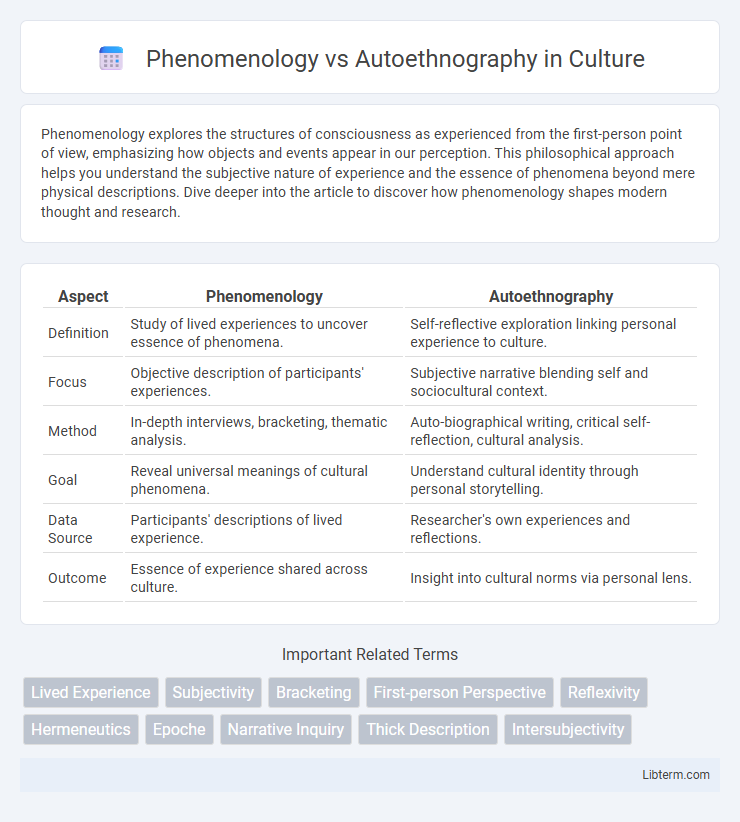Phenomenology explores the structures of consciousness as experienced from the first-person point of view, emphasizing how objects and events appear in our perception. This philosophical approach helps you understand the subjective nature of experience and the essence of phenomena beyond mere physical descriptions. Dive deeper into the article to discover how phenomenology shapes modern thought and research.
Table of Comparison
| Aspect | Phenomenology | Autoethnography |
|---|---|---|
| Definition | Study of lived experiences to uncover essence of phenomena. | Self-reflective exploration linking personal experience to culture. |
| Focus | Objective description of participants' experiences. | Subjective narrative blending self and sociocultural context. |
| Method | In-depth interviews, bracketing, thematic analysis. | Auto-biographical writing, critical self-reflection, cultural analysis. |
| Goal | Reveal universal meanings of cultural phenomena. | Understand cultural identity through personal storytelling. |
| Data Source | Participants' descriptions of lived experience. | Researcher's own experiences and reflections. |
| Outcome | Essence of experience shared across culture. | Insight into cultural norms via personal lens. |
Introduction to Qualitative Research Approaches
Phenomenology emphasizes exploring individuals' lived experiences to understand the essence of phenomena, while autoethnography combines self-reflection with cultural analysis to connect personal narratives to broader social contexts. Both methods are essential qualitative research approaches, with phenomenology prioritizing depth in subjective experience and autoethnography blending autobiography and ethnography for nuanced sociocultural insights. Selecting between them depends on whether the research focus is on universal experiential meanings or on interpreting self within culture.
Defining Phenomenology: Core Principles and Aims
Phenomenology centers on exploring lived experiences to uncover the essence and meaning of phenomena through conscious reflection. It emphasizes intentionality, describing how individuals perceive and make sense of their world without preconceived theories. Core aims include capturing subjective realities and revealing universal structures underlying personal experiences.
Understanding Autoethnography: Methods and Motivations
Autoethnography combines autobiographical storytelling with ethnographic research, emphasizing personal experience to explore cultural phenomena. This method involves deep self-reflection, participant observation, and narrative analysis to connect individual stories with broader social contexts. Motivations for using autoethnography include revealing marginalized voices, challenging dominant narratives, and fostering empathy through intimate, lived experiences.
Philosophical Foundations: Phenomenology vs Autoethnography
Phenomenology is grounded in the philosophical tradition of Husserl and Heidegger, focusing on the essence of lived experiences and the structures of consciousness. Autoethnography draws from postmodern and interpretivist philosophies, emphasizing personal narrative as a means to explore cultural and social contexts. Both methodologies prioritize subjective experience but differ in ontological assumptions: phenomenology seeks universal meanings, whereas autoethnography embraces reflexivity and situated knowledge.
Research Focus: Lived Experience vs Personal Narrative
Phenomenology centers on exploring the essence of lived experiences by examining how individuals perceive and make sense of phenomena, emphasizing universal meanings across participants. Autoethnography focuses on the researcher's personal narrative, using self-reflection and storytelling to connect individual experiences with broader cultural, social, or political contexts. Both methodologies prioritize subjective experience, yet phenomenology aims for generalized understanding, while autoethnography highlights unique, contextualized self-exploration.
Data Collection Techniques: Interviews, Observation, and Reflection
Phenomenology utilizes in-depth interviews and participant observation to capture lived experiences, emphasizing bracketing and thematic analysis for data interpretation. Autoethnography relies heavily on self-reflection and narrative writing, often complementing personal diaries and memory recall, allowing researchers to connect individual experience with broader cultural contexts. Both methods prioritize rich qualitative data, but phenomenology focuses on collective meaning, whereas autoethnography centers on subjective, introspective insight.
Role of the Researcher: Objectivity and Subjectivity
Phenomenology emphasizes the researcher's attempt to bracket personal biases and achieve objectivity by focusing on participants' lived experiences. Autoethnography embraces subjectivity, positioning the researcher as both the subject and the investigator, using personal narratives to connect individual experiences to broader cultural contexts. The researcher's role in phenomenology is to remain detached, while in autoethnography, they are deeply engaged and reflective, highlighting the interpretive nature of knowledge construction.
Analytical Strategies in Phenomenology and Autoethnography
Phenomenology employs analytical strategies that focus on describing and interpreting lived experiences through processes such as epoche, reduction, and imaginative variation to reveal the essence of phenomena. Autoethnography utilizes reflective and narrative analytical techniques to connect personal experience with broader cultural, social, or political contexts, often employing thematic analysis and storytelling. Both methods emphasize deep understanding, but phenomenology centers on universal essences while autoethnography highlights subjective and contextualized self-exploration.
Applications in Social Sciences and Humanities
Phenomenology in social sciences and humanities is applied to explore individuals' lived experiences and the essence of phenomena, emphasizing subjective consciousness and meaning-making processes. Autoethnography merges personal narrative with cultural analysis, enabling researchers to connect individual experiences with broader social contexts and power structures. Both methodologies facilitate deep qualitative insights but differ as phenomenology prioritizes abstraction of experience, whereas autoethnography centers on self-reflective storytelling within social frameworks.
Strengths, Limitations, and Choosing the Right Approach
Phenomenology excels in exploring lived experiences through deep, descriptive analysis, providing rich insights into individual perceptions, but it may be limited by its abstract focus and sometimes challenging interpretation. Autoethnography offers a unique strength by combining personal narrative with cultural analysis, fostering reflexivity and emotional depth, though it can be criticized for potential subjectivity and limited generalizability. Choosing between phenomenology and autoethnography depends on research goals: use phenomenology to understand essence and universal meaning of experiences, and autoethnography to connect personal experience with broader social contexts.
Phenomenology Infographic

 libterm.com
libterm.com